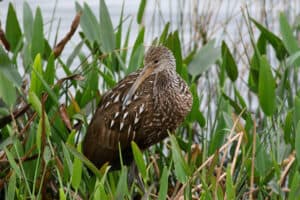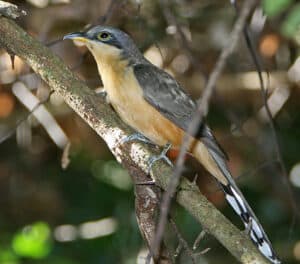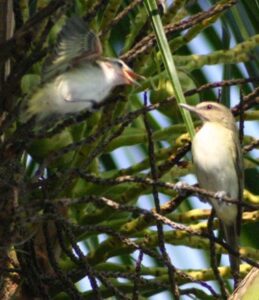1. Snail Kite

Florida is the only state in the United States in which the snail kite breeds. It is, however, a widespread neotropical species, breeding from Mexico south to Ecuador and Brazil. In Florida it is a rather rare resident of the central and southern portions of the state. The snail kite is found in freshwater marshes with extensive stands of sawgrass and cattails. This species feeds exclusively on apple snails which inhabit these marshes but are sensitive to water level fluctuations. Snail kites therefore tend to be nomadic, moving from year to year in response to differing levels of prey abundance. They breed most commonly south of Orlando, with concentrations around Kissimmee and also around Lake Okeechobee and the northern Everglades. Particularly good spots to see snail kites include the area west of the Miccosukee Restaurant along the Tamiami Trail in the Everglades and also west of Canoe Creek Road along the eastern side of Lake Kissimmee.
The snail kite is a medium-sized raptor, about the size of a red-shouldered hawk. The male is uniform slate blue/gray with a white rump and undertail coverts, bright red cere and red legs. The female is much browner with a white face and supercilium and dark eye line and malar stripe. Juveniles are browner still and heavily streaked on the underparts, with much duller legs and bill. The bill is quite sharply hooked, an adaptation for extracting snails from their shells. Snail kites hunt relatively low over their favored habitat on broad, paddle shaped wings. They are rarely heard vocalizing.
2. Short-tailed Hawk

In the United States the short-tailed hawk is found only in Florida as a nesting species, and is a very rare vagrant in Texas and Arizona. It breeds largely in northern and central Florida and winters in southern Florida and on the Keys. It has a much more extensive range in Central and South America, being found as far south as Peru and Bolivia. In the breeding season short-tailed hawks are particularly fond of cypress swamps but are also found in a variety of other habitats near water including hardwood hammocks, pine woods, and mangrove swamps. They are highly aerial, soaring on thermals, often in company with flocks of vultures, and are rarely see perched. They hunt on the wing and prey mostly on small birds. Short-tailed hawks are most easily observed in the winter in the Everglades, with Eco Pond at Flamingo, the Anhinga Trail at Royal Palm Hammock, and Paurotis Pond being among the best spots.
The short-tailed hawk is about 16 inches in length and occurs in two color morphs. The more common dark morph is very dark all over with pale undersides to the flight feathers and a barred tail. The light morph is dark above and completely white underneath with white wing linings, barred flight feathers, and a barred tail. The call is a high pitched whistle.
3. Limpkin

Apart from a few in extreme southern Georgia, the limpkin only breeds in Florida in the United States. Otherwise it is found over large areas of Central and South America. The limpkin is most closely related to the rails and cranes. It is a largely crepuscular bird, being seen more often at dawn and dusk than in the middle of the day. Limpkins are found in freshwater marshes and cypress swamps around the edges of lakes throughout Florida but they are rare in much of the Panhandle and on the Keys. They feed largely on apple snails and freshwater mussels, occasionally taking lizards and frogs.
Particularly good places to see limpkins in Florida include Wekiwa Springs near Orlando, Orlando Wetlands Park, Wakulla Springs in the Panhandle, Corkscrew Swamp, Loxahatchee National Wildlife Refuge, and Shark Valley in the Everglades.
Limpkins are fairly large birds, being more than two feet long and shaped rather like a long-legged rail. The plumage is distinctive being dark brown all over, marked liberally with large white spots on the neck, back, wings, and underparts. The neck is paler and heavily streaked with white. The long legs are black and the long, decurved bill is yellowish-orange on the basal two thirds. Particularly at dusk and at night the limpkin is highly vocal giving a loud high pitched scream, krreeeah.
4. Purple Gallinule

One of our most colorful breeding species, the purple gallinule is found throughout the southeastern United States and Central America south to Chile and Argentina. In Florida the purple gallinule is patchily distributed, being fairly common where it occurs but also absent from many areas of seemingly suitable habitat. It is a little more secretive than its much-more-abundant cousin, the common gallinule (common moorhen). It inhabits much the same areas as that species, being fond of freshwater marshes with extensive stands of cattails and emergent vegetation. With its long toes it is particularly well adapted to walking on floating plants, especially water lilies and spatterdock. Purple gallinules eat the seeds of aquatic plants and also insects. Good places to look for purple gallinules include Eco Pond and Shark Valley in Everglades National Park, Orlando Wetlands Park, numerous lakes around Kissimmee and Lakeland, and around Lake Okeechobee.
The adult purple gallinule is an unmistakable and extremely beautiful bird. The head, neck, and underparts are a deep indigo blue, and the upperparts are uniformly bright green. The bill is bright red tipped with yellow, and there is a pale blue bill shield on the forehead. The legs are bright yellow and the undertail coverts pure white, unlike those of the common moorhen, which have a distinctive dark central stripe. Juveniles are much less brightly colored, being dull green on the upperparts with a sandy brown head and neck and whitish underparts. The bill is dark brown. Purple gallinules are generally silent but they have a wide variety of calls, many of them resembling those of the common moorhen.
5. White-crowned Pigeon

This Caribbean species is found only in southernmost Florida and on the Keys in the United States. The breeding range extends throughout the Greater and Lesser Antilles to the Yucatan Peninsula and Belize. White-crowned pigeons are found largely in mangrove swamps and West Indian hardwood hammocks, a rapidly disappearing habitat now found in small stands in Florida. Here they frequent the treetops feeding on the fruit of various fig species, poisonwood and cocoa plum trees, sea grape, and gumbo limbo. They are relatively shy and can be difficult to approach. Most easily seen in flight they can occasionally be found perching in treetops or on telephone wires.
The best places to see white-crowned pigeons include Everglades National Park, Key Largo Hammock State Park, and from US 1 down the Florida Keys as far as Key West.
The white-crowned pigeon is a relatively large, dark pigeon, approximately 14 inches long. The plumage is largely dark, charcoal gray. The adult has a pure white forehead and crown and also iridescent green nape feathers. The bill is red with a yellow tip and the legs are red. The juvenile is duller and lacks the white crown. The call is a cooing woo-oop, woo.
6. Mangrove Cuckoo

As its name suggests, this species is found in only mangrove swamps around the Florida coastline as far north as Tampa Bay on the Gulf Coast. It is decidedly scarce and difficult to observe due to its secretive habits and retiring nature. Mangrove cuckoos are also found in coastal West Indian hardwood hammocks. Outside Florida the species occurs throughout the Caribbean and also from the coasts of Mexico through Central America to Brazil. The best places to observe mangrove cuckoos in Florida include mangrove swamps in the Keys, particularly on Upper Key Largo and Sugarloaf Key, along the Buttonwood Canal in Everglades National Park as well as at Weedon Island Reserve in Tampa Bay and at Ding Darling Nature Reserve on Sanibel Island. Easiest to find in April when it is calling.
Mangrove cuckoos are 12 inches long, with long pointed wings, and they are superficially similar to yellow-billed cuckoos. The upperparts are a light brown in color and the crown is gray. There is a pronounced blackish eye line and the underparts are white with a rich apricot suffusion, especially on the belly. The tail is black with bold white tips to the feathers when seen from the underside. The call is a ringing caw, caw, caw, caw, caw, cah, cah, the last two syllables being lower in pitch than the first few.
7. Burrowing Owl

The burrowing owl is a wide-ranging species, found from Canada south through the western United States and locally in the Caribbean and South America as far south as Tierra del Fuego. Those found in Florida represent a totally disjunct population and are different enough to perhaps one day warrant separate species status. Burrowing owls are unique among North American owls in that they spend a great deal of their time underground, roosting and nesting in burrows. It is not known for certain whether they excavate their own burrows or use the abandoned burrows of gopher tortoises. Breeding sites include golf course, airports, agricultural pastureland, and even suburban lawns. The current state population of these owls is thought to be at least 3,000 pairs. Although active during the day (when they can often be seen standing at their burrow entrances) burrowing owls hunt most often in the evening or at night. They feed on a wide variety of insects including earwigs, grasshoppers, and beetles as well as on frogs and small rodents. Good places to look for burrowing owls in Florida include suburban areas in Cape Coral and Punta Gorda, farmland around Lorida, several airports in the Miami area, and on golf courses at Marathon in the Keys.
The Florida race of the burrowing owl measures about 10 inches long. The plumage is largely brown, spotted with white. The bird has white “eyebrows” and a white chin and throat and is heavily barred on the underparts, with a white spotted breastband. The bill is yellow. Calls vary from a double coo to a chwee-chikit-chik and various barking and clucking notes.
8. Gray Kingbird

In early April the first gray kingbirds arrive along Florida’s coasts from wintering grounds in the Caribbean. Other than Florida they only occur as a breeding species to Georgia in the north and Mississippi in the west. Gray kingbirds are most abundant on the Keys and along the Gulf Coast north to Tampa Bay. Throughout this limited range it is largely a coastal species being found predominantly in mangrove swamps but also in pine woods and hardwood forests. It is seen rather infrequently inland, largely during migration, except in the southern tip of Florida where it breeds. It is a noisy, conspicuous species which chooses prominent perches on telephone wires and dead snags on the tops of trees. Gray kingbirds can be found quite easily all along the Florida Keys, in the Everglades, at Ding Darling National Wildlife Refuge, Fort DeSoto County Park, Cockroach Bay south of Tampa, and at Honeymoon Island State Recreation Area.
Gray kingbirds are 9 inches in length, with a slightly forked tail. The upperparts are uniform pale gray with a couple of indistinct pale wing bars. There is a dark mask through the eye and the underparts are pure white in adults and with a very slight yellowish tinge in young birds. The bill is heavy and black. The call is a buzzing preeeer.
9. Florida Scrub-jay

This is Florida’s only truly endemic breeding species, a bird which is literally found nowhere else in the world, having been split off taxonomically from its two closely related western cousins, the western scrub-jay and island scrub-jay. Nowadays the Florida scrub-jay is a highly threatened species due to large scale development of its favored habitat; young open oak scrub generally less than 15 feet tall. This habitat is dependent on periodic burning for its propagation. The bird is therefore dependent on habitat management by fire for its survival.
The Florida scrub-jay has an unusual breeding strategy. It lives in groups of several birds, and many pairs have one or more helpers at the nest. These helpers are young birds not yet old enough to breed. It is estimated that only about 4,000 groups of Florida scrub-jays still exist, which is a small fraction of their historical abundance. Good spots to see them are the road out to Playalinda Beach at Merrit Island, Oscar Scherer State Park near Sarasota in Ocala National Forest, and the Archbold Biological Station south of Lake Placid along the Lake Wales Ridge.
Florida scrub-jays are 11 inches long. The head, neck, wings, and tail are largely bright blue with a fawn colored mantle and pale gray underparts. There is a blue crescent on the breast a pronounced white supercilium. The call is a harsh shreesh.
10. Black-whiskered Vireo

Florida represents the northernmost extent of the black-whiskered vireo’s breeding range. However, it is decreasing in the state, probably due to brood parasitism by brown-headed cowbirds. Elsewhere it breeds largely in the Bahamas and the Greater and Lesser Antilles. It is a summer visitor to Florida, arriving in March and April and leaving in September. The black-whiskered vireo inhabits coastal mangrove swamps and West Indian hardwood hammocks. It can be found most easily along the Florida Keys, especially in places such as Key Largo Hammocks State Park. It also occurs in the Everglades and at Ding Darling National Wildlife Refuge. During spring migration it occurs regularly on the Dry Tortugas.
This species is superficially similar to the much-more-numerous red-eyed vireo which, however, does not breed in southern Florida or in the mangrove swamps favored by the black-whiskered vireo. It has a slightly larger bill than the red-eyed vireo and a duller red eye. The thin black “whisker” can be rather difficult to see. The black-whiskered vireo has duller head markings and shows brighter yellow undertail coverts. The song is similar to the red-eyed vireo but the phrases are doubled or tripled.




